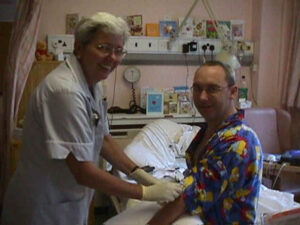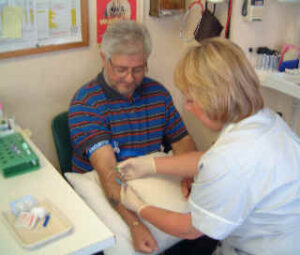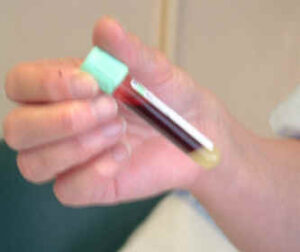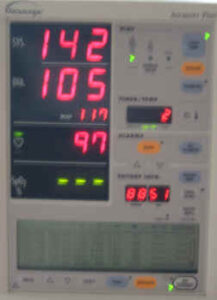Blood Tests
_____

Diana taking some blood a few days after transplant, this seemed to happen everyday.
Yes I really did wear that dressing gown in hospital after my transplant, I packed my bag ready before transplant. Then my dear family repacked it with loads of outrageous cloths while I was having my operation and wouldn’t bring me anything else to wear. God knows who they get it from?
Blood tests
They are really important after your transplant, the hospital can check several things from these tests, drug levels, cholesterol level, blood cell count and various infections.

This is Dina about to take some blood from Bob (heart recipient), note Dina is using a Butterfly type needle. These needles are smaller than normal and are for hard to get to veins or people with small veins. An elastic tourniquet is used to restrict the blood flow and make the vein more prominent.
The blood is put into files (test tubes) and sent to the lab for testing.

As you can see the files are not very big and they already have various chemicals in them ready for each test, there are different files for each test.
Also part of the blood test is to have your Blood Pressure checked.

This is my blood pressure result for today.
Systolic pressure – the pressure when the beat or contraction of the heart forces the blood around the circulation
Diastolic pressure – the lowest pressure, which occurs between heartbeats
As you can see my systolic pressure is 142 and my Diastolic pressure is 105
My heart rate at rest is 97 beats per/min
I added this page after Dina nagged me on the phone for missing out her department on the website.
I hope you are a happy bunny again now Dina (the little bleeder)
Dina & Diana
____
ABO’ BLOOD TYPES
A simple blood test is performed to determine the correct blood type of a donor and recipient. Here’s how your blood type should be compatible with your potential donor’s blood type:
• If you are blood type A, your donor should have blood type A or O
• If you are blood type B, your donor should have blood type B or O
• If you are blood type O, the donor must have blood type O (type O is called the “universal donor”)
• If you have blood type AB (the “universal acceptor”), your donor can have blood type AB, A, B or O
Below is a brief explanation of the most common blood tests.
Most people do not need all of these values checked, so please don’t be alarmed by the long list. Your Doctor will have decided which ones in your specific case are most appropriate to measure.
SODIUM is an ion (electrolyte) that is important in the conduction of nerves, contraction of muscles, and functioning of cells. It is controlled primarily by the kidneys and adrenal glands and is elevated or suppressed in many diseases (for example, severe dehydration can elevate it). It is also affected by medicines, including diuretics used in the treatment of hypertension.
POTASSIUM is important for muscles and nerves to function properly and its balance in the body is controlled by the kidneys. Medications, especially diuretics can lower it dramatically whereas other medications such as “ACE inhibitors” used for hypertension can raise it. Kidney diseases can also elevate it in addition to accidental breakdown of cells during blood drawing or processing.
CHLORIDE, like sodium, is an ion that is important in the conduction of nerves, contraction of muscles, and functioning of cells. An elevated or depressed number is most often associated with abnormalities of the other electrolytes listed above.
GLUCOSE is a measure of the sugar content in blood and is used to evaluate diabetes or hypoglycemia. It is usually tested in a fasting state (no food for 12 hours). One elevated number does not give one the diagnosis of diabetes and often multiple measurements need to be done to evaluate it completely.
BLOOD UREA NITROGEN (BUN) is a waste product of protein metabolism. It is produced in the liver and excreted by the kidneys. When protein metabolism or the kidneys are not working properly, high values may occur. Low values can be seen in malnutrition or low muscle mass.
CREATININE is another waste product of protein metabolism and represents the function of the kidneys (a high value indicates worsening kidney function).
URIC ACID is a constituent in the blood which is normally excreted in the urine to rid the body of nitrogen. Values that are high may indicate gout or kidney problems. A low value is not clinically significant.
TOTAL PROTEIN is the total amount of protein circulating in the blood. This value represents general nutritional habits.
ALBUMIN is plasma protein which transports fatty acids, bilirubin and poorly saturated hormones in the blood. High values are not clinically significant but low values can be seen in chronic disease states.
GLOBULIN is a class of proteins which are important in the immune system.
CALCIUM is important for normal function for the heart, nerves and muscles and is controlled by the kidneys and parathyroid glands. Both elevated and depressed levels can be signs of disease.
PHOSPHORUS is a component of bone and occurs in all tissues. Abnormal values are usually seen in combination with other lab abnormalities (such as calcium).
LDH stands for lactate dehydrogenase. It is an enzyme involved in the breakdown of lactic acid. Anything that causes cellular damage, including heart attacks, liver disease, and blood drawing itself can cause high values.
SGOT (or ALT) stands for serum glutamic oxaloacetic tranaminase. SGOT is an enzyme involved in cellular functions of the heart and liver. Alcohol consumption, liver disease and heart attacks raise this value. Low values are not clinically significant.
SGPT (or AST) stands for serum glutamic pyruvic transaminase. SGPT is an enzyme involved in the functions of heart, liver, and muscle cells. Alcohol consumption, liver disease and heart attacks raise this value. Low values are not clinically significant.
ALKALINE PHOSPHATASE is an enzyme found primarily in bones and liver, therefore diseases affecting these organs can result in elevated levels. Low values are not clinically significant.
GGTP stands for gamma glutamyl transpeptidase and is an enzyme involved in the function of heart, liver, and muscle cells. Diseases affecting these organs raise this value. Low levels are not clinically significant.
TOTAL BILIRUBIN is a bile pigment formed by the breakdown of red blood cells. It normally circulates in the plasma and is taken up by the liver. Liver disease or excessive breakdown of red blood cells can therefore cause an increase in this level causing jaundice. Low levels are not clinically significant.
FERRITIN is a sensitive indicator of iron stores (in the absence of liver disease or inflammation which can elevate the value). Low values may represent iron deficiency or anemia.
TRIGLYCERIDES are fats which are the usual storage form of lipids in the body. This value can be dramatically affected by a recent meal, thus an 12 hour fast is required for accurate results. Low values are not clinically significant.
CHOLESTEROL is used to make essential body substances such as cell walls and hormones. High levels of cholesterol have been associated with an increase risk for heart disease. Low levels are not considered to be clinically significant (though studies are ongoing to evaluate this further). No fasting is necessary for this test but levels can fluctuate day to day and variations of 20 points are not usual. Therefore, one single test is not enough to determine if one has high cholesterol, often 3 separate values over a period of months are obtained before medical therapy is started (though diet therapy is often recommended).
HDL CHOLESTEROL is a high density lipoprotein which is commonly referred to as the “good” cholesterol. HDL is a transport protein which carries cholesterol away from the vessel wall for removal from the body. The higher the HDL value, the lower the risk of coronary artery disease. Exercise and diet have been shown to increase the HDL level whereas smoking decreases it.
LDL CHOLESTEROL is a low density lipoprotein which is commonly referred to as the “bad” cholesterol. LDL transports cholesterol to the vessels. The lower the LDL value the lower the risk of coronary artery disease. A low saturated fat/low cholesterol diet can lower this value.
CHOLESTEROL/HDL RATIO is a ratio of total cholesterol to HDL cholesterol and is used by some physicians as a predictor of coronary artery disease (others prefer to look at the HDL and LDL trends separately.) A lower ratio is equal to a lower risk of cardiovascular disease.
WBC stands for white blood cell count which reflects the immune system as these cells are the infection fighting cells. The value can be elevated in acute and chronic infections and in malignancies such as leukemia. The WBC differential is a measurement of the various types of white blood cells and is used if the WBC value is abnormal.
RBC stands for red blood cell count. These cells carry oxygen to the body. Low values are seen in anemia and other diseases but physicians usually use hemoglobin or hematocrit to describe the severity of the anemia (see below.)
HEMOGLOBIN (HGB) is the oxygen carrying component in the red blood cell. Low values are seen in anemia and high values in smokers and people with lung disease.
HEMATOCRIT (HCT) is the volume (percentage) of red blood cells in whole blood and is used to evaluate anemia and other diseases (see hemoglobin.)
Transplants Save Lives

We totally rely on donations to fund the charity, including this website which has remained free for over 21years.
We are very reluctant to add google ads etc, so please make a small donation to help pay for the day to day running costs of the charity and website.
Note we are non-profit and run totally by volunteers.
To Transplant & Beyond is a UK registered non-profit charity No 1106248
© 2000 All rights reserved

